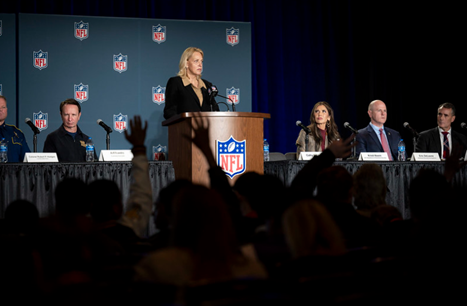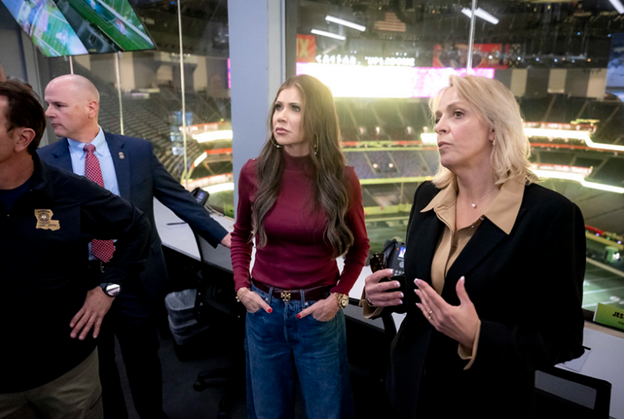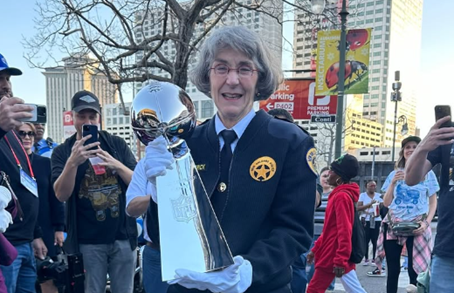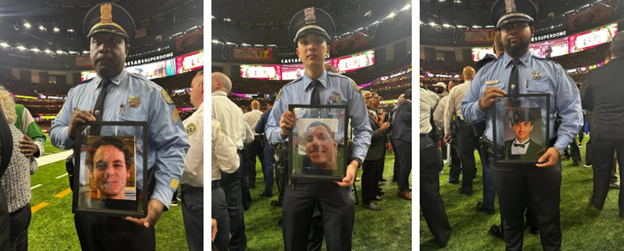|
February 15, 2025 Protecting the Super Bowl
PERF members, While last weekend’s Super Bowl may not have been the closest game, it was seen by a record number of viewers and attended by more than 65,000 fans. And law enforcement officials were on high alert after a U.S. Army veteran drove his vehicle into a crowd on Bourbon Street in New Orleans on January 1, killing 14 pedestrians. The attacker, who had been inspired by the Islamic State, was eventually killed in a shootout with police. He had also placed two bombs nearby that failed to detonate. On Thursday I spoke with NFL Senior Vice President and Chief of Security Cathy Lanier and New Orleans Police Superintendent Anne Kirkpatrick about protecting the Super Bowl. Chief Lanier became the NFL’s Chief Security Officer in 2016. Before working for the NFL, she spent her entire career with the Washington (D.C.) Metropolitan Police Department, serving as its chief from 2007 to 2016. Superintendent Kirkpatrick has led the New Orleans Police Department since September 2023. She previously served as the police chief in Oakland, California, and three Washington cities: Spokane, Federal Way, and Ellensburg. Both spoke about protecting the dignitaries, celebrities, and fans attending the game; the division of labor between the law enforcement agencies involved and the NFL’s security team; and advice they’d give to law enforcement agencies hosting future Super Bowls. CATHY LANIER Wexler: This is your ninth Super Bowl as the NFL’s chief security officer. How did this one compare to the previous eight? Cathy Lanier: Every single one has some unique challenges. Sometimes the venue is really, really difficult to secure. Sometimes the local government is really difficult to figure out and maneuver. Sometimes there’s just a real shortage of resources because the jurisdiction is smaller. In Minneapolis it was 25 below zero. So every one of them has had its “How are we going to get around this?” thing. New Orleans had a lot of little things. Most importantly, there was a terrorist attack on January 1. Wexler: What are the differences between your current role and your previous role as police chief in Washington, D.C.? Is one harder than the other? Lanier: They’re harder in different ways. In the police chief job, you’re always under a microscope. You’re constantly trying to defend your department and police officers. And quite often, you’re trying to defend people who have done nothing wrong. It’s a unique stress, because things are put out in the media or on social media that are wrong but you can’t correct once they’re out there. So that was stressful for me. The only thing I ever felt really stressed about was defending my agency. I had great police officers who did great work and I wanted to defend them all the time. And it was very hard to do, because there were always people looking to poke holes in everything we did. In the private sector, I don’t have that kind of pressure, but this is a hard job. It’s a lot more physical work. When I interview people for high-level positions, one of the questions I ask is, “When is the last time you moved a bike rack?” Because not only are we responsible for orchestrating the plan, if we get out there on game day and the bike rack is not in the right place or there’s a hole in the fence, I have to fix it. So this job is much harder physically and the complexities of the security are much more significant.
Cathy Lanier discusses security measures during a Super Bowl press conference. Source: DHS on Flickr Wexler: What are your team’s responsibilities around the Super Bowl? Lanier: My team usually is on the ground about a month in advance. We make multiple trips there throughout the year, then we kind of live there that last month. When the teams arrive, we pick them up and get them to their hotels. We have to secure the two team hotels. We have to secure the two team practice sites. We have to make sure security is coordinated for all their movements. Monday night is opening night, with about 30–35,000 people and thousands of international press. The NFL Experience gets 20–25,000 people a day starting Tuesday or Wednesday and running through the course of the week, typically at the convention center. Then we have the NFL House, which is a large hospitality event that was going on down in the French Quarter at Arnaud’s. That went on from Wednesday through Saturday. We have the commissioner’s party on Friday night. That’s about 8,700 guests—all the owners, head coaches, general managers, and the commissioner’s invited guests. And we have the ongoing challenge of all the dignitaries who come in and attend multiple events. We had multiple governors, the Speaker of the House, and the majority whip. We have about 10 days of events. Those are the big ones, but there are dozens of one-offs and we’re responsible for security for all of them.
Cathy Lanier discusses Super Bowl preparations with Homeland Security Secretary Kristi Noem at the Superdome. Source: DHS on Flickr Wexler: How did the January 1 terrorist attack affect your planning? Lanier: We have a best practices standard that we’re SAFETY Act–certified for, so our levels of security protocols are so high that we are certified by the Department of Homeland Security for SAFETY Act protections. That means we have 100 percent liability protection if a terrorist attack were to occur at one of our events because we meet this very high standard. The second thing that helps is that we’re a SEAR 1 event. So I’m already going to have 15 to 20 federal agencies that are bringing in additional resources to support me. So this year, following the terrorist attack and adding on a POTUS [President of the United States] visit, our standards really didn’t have to change that much. Working through the dignitary arrivals led to some changes in logistics. But we’ve always done the protection level for hostile vehicle mitigation at all of our sites. We’ve always done PBIED—Person-Borne Improvised Explosive Device Detection. We’ve always had 300-foot perimeters. We’ve always protected our crowds from vehicles. That terrorist attack showed us that there are still people out there who are capable of planning a complicated attack. That was a complicated attack. It didn’t go off the way he wanted it to go off, and it could have been much, much worse. That was a reminder that all the things we do are relevant. Because he had every element. He had a firearm. He had the vehicle as a weapon. He had improvised explosive devices. He had fire as a weapon. That’s just a reminder that the standards we have are there for a reason, and we can’t give on those standards no matter the circumstances. Wexler: You’ve testified before Congress and spoken at PERF meetings about the security threat posed by drones. Does holding the Super Bowl in a domed stadium take that concern out of the picture? Lanier: It helps. It takes the possibility of drones disrupting the game out of the picture. But I still have large crowds gathering. About 60–65 percent of the attendees came in through the main entrance, and there was a mass of people about six blocks long walking down the street to that entrance. They were coming into our staging area, then our queue lines, then into our screening tents. Those people are all vulnerable. And then there are the team movements. If you really want to hit the Super Bowl, the stadium on game day is an extremely hard target, so you’d go after those teams at the team hotels or when they’re moving from place to place. So security on those teams when they move is extremely high, particularly on game day. Wexler: How did the president’s attendance affect your security measures? Lanier: This was the first sitting president to attend the game. We’ve had former presidents, and we’ve had first ladies. But we’ve not had a sitting president come to a Super Bowl. For me, it adds the integration of Secret Service into our operations. We’ve been planning for two years. We have every detail of the whole day choreographed down to the minute. And now we have to integrate Secret Service, because there are certain requirements they have to meet. So the hardest part for us was integrating the Secret Service in the last five days before the Super Bowl when we’ve been planning for two years. Wexler: Do you love the job as much as you did when you started nine years ago? Lanier: I love a challenge, and the Super Bowls never disappoint. There are always challenges. And if I were bored, I’d probably be on to something else by now. Wexler: Is there anything else you’d like to add? Lanier: My relationship with law enforcement partners has been the best. State and local law enforcement agencies have to step in when the Super Bowl comes to a city. It’s a tremendous ask and a huge lift for the local police. In New Orleans, it was Jefferson Parish, the state police, and NOPD. They were amazing and stretched the resources they had for everything we asked for. Hats off to the state and locals. It’s a huge lift, and they always rise to the occasion. SUPERINTENDENT ANNE KIRKPATRICK Chuck Wexler: How are you feeling after Super Bowl weekend, which I’m sure was a whirlwind? Superintendent Anne Kirkpatrick: I feel really good. The execution and outcome were even better than I expected. I knew it would be good, but you still hold your breath. So I’m very pleased. Wexler: While this is happening in your city, you have a lot of help from the NFL’s security team and other law enforcement agencies. How do you divide up responsibilities? Superintendent Kirkpatrick: It’s quite a logistical challenge. The NFL security team is led by Cathy Lanier, and I cannot say enough glowing things about her. She is fantastic and incredibly competent. The NFL has the lead for the venues associated with the Super Bowl. But in New Orleans, everybody is going to come out of the Super Bowl and go to the French Quarter, and the French Quarter is not under their security footprint. So it’s a logistical dance to sort out what is our responsibility and what is the NFL’s responsibility.
Superintendent Anne Kirkpatrick with the Lombardi Trophy. Source: NOPD on Instagram Wexler: How did the January 1 terrorist attack change your approach to policing in the French Quarter? Superintendent Kirkpatrick: For those who have never been to New Orleans, Bourbon Street is not an enclosed pedestrian right of way. It is a street that is traveled vehicularly during the day, but at night we close it down to vehicle traffic so it becomes a pedestrian walkway. We can close it down entirely, but will the community tolerate it? The community will tolerate security to a point, but it becomes a balancing act, because businesses say, “Wait a second, we lost business because people couldn’t get their vehicle to the restaurant.” And 3,000 people, including me, make the French Quarter their home. So we can put barricades up and close the French Quarter to vehicle traffic, but it will impact tourism and be extremely inconvenient for people, so they don’t want to. We’re still in that balancing act of determining how much security the city will tolerate. Wexler: What advice would you give a police chief in a city hosting a future Super Bowl? Superintendent Kirkpatrick: You want to begin planning for worst-case scenarios very early, including worst-case scenarios associated with high-profile targets coming to your city. You need to actually get in the mindset of a terrorist, and understand the Super Bowl is a global target for anyone looking to make a statement with a global impact. Wexler: How does the event’s SEAR 1 designation help you protect the city? Superintendent Kirkpatrick: All Super Bowls have SEAR 1 status, and it means you get an incredible amount of resources. Whatever barriers you need, whatever helicopters you need, you’re going to get. We needed 120 to 150 bomb dogs, and TSA provided those to us. We had about 15 SWAT teams from the FBI, HSI, and our own agency. Wexler: Last question: Where were you during the Super Bowl? Superintendent Kirkpatrick: I was in the dome, doing many laps. I was invited onto the field for the coin toss, because we honored the 14 victims of the January 1 attack, as well as our three officers who were heroic and killed the attacker. I met the president of the United States. I made laps around the Superdome to make sure people were in their places. So I was in the Superdome for most of the game, and at the very end, I got out to watch the egress as people left.
The three NOPD officers who stopped the January 1 attack honor the victims on the field before the game. Source: NOPD on Instagram Thanks to Superintendent Kirkpatrick and Chief Lanier for taking the time to share their insights with our members! Best, Chuck
|




